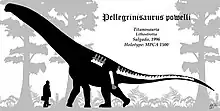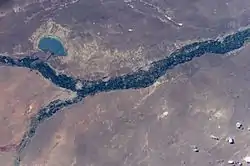Pellegrinisaurus
Pellegrinisaurus (meaning Lizard from Pelligrini) is a genus of titanosaurian sauropod dinosaur that lived in South America during the Late Cretaceous period. The holotype was found in the Allen Formation, Argentina.[1]
| Pellegrinisaurus | |
|---|---|
 | |
| Diagram showing known fragments from the holotype | |
| Scientific classification | |
| Kingdom: | Animalia |
| Phylum: | Chordata |
| Clade: | Dinosauria |
| Clade: | Saurischia |
| Suborder: | †Sauropodomorpha |
| Clade: | †Sauropoda |
| Clade: | †Eusauropoda |
| Clade: | †Neosauropoda |
| Clade: | †Macronaria |
| Clade: | †Titanosauria |
| Clade: | †Lithostrotia |
| Family: | †Saltasauridae |
| Subfamily: | †Opisthocoelicaudiinae |
| Genus: | †Pellegrinisaurus Salgado, 1996 |
| Type species | |
| †Pellegrinisaurus powelli Salgado, 1996 | |
Discovery and naming

The assigned holotype, MPCA 1500, was discovered in 1975 by Roberto Abel and his assistant Jaime Emilio Powell. It was recovered from the lower member of the Allen Formation in the locality of Pellegrini Lake, Argentina, dating from the Late Cretaceous, Campanian to lower Maastrichtian, but it was not formally described until 1996 by Leonardo Salgado. Initially, the recovered remains were referred to Epachthosaurus, but later this hypothesis was abandoned because MPCA 1500 did not share derived features with the holotype of Epachthosaurus. The generic name Pellegrinisaurus refers to Pellegrini Lake, where the specimen was found. The specific name powelli is in honour of Jaime E. Powell.[1]
Description
Pellegrinisaurus is a rather large titanosaur. The estimated body size is about 20–25 m (66–82 ft). The holotype includes an incomplete right femur, twenty-six caudal and four dorsal vertebrae. Autapomorphic features of Pellegrinisaurus, by which it can be distinguished, are:
- The ventral side of the centrum of the dorsals has a transverse width equal to twice the dorsoventral (vertical) depth.
- The mid-posterior and posterior caudals are anteroposteriorly (horizontally) elongated and have dorsoventrally depressed neural spines, the anterior ends of which are higher anteriorly than posteriorly.
Pellegrinisaurus differs from other titanosaurs by having anteroposteriorly elongate and dorsoventrally depressed mid-posterior and posterior caudal spines; Salgado interpreted this condition as an extra-articulation between the neural spine and the articular process of the subsequent vertebra, that reduced tail movement.[1]
The right femur is partially preserved. It is anteroposteriously compressed with a very flattened fourth trochanter. Laterally, it features a pronounced bulge similar to that of Chubutisaurus, brachiosaurids and other titanosaurs.[1]
Paleoecology
Pellegrinisaurus was unearthed from the Allen Formation, in which it probably lived alongside other titanosaurs, such as Aeolosaurus and Rocasaurus.[2] Salgado suggested that contemporaneous hadrosaurids and the titanosaur Aeolosaurus inhabited coastal lowlands while other larger titanosaurs (such as Pellegrinisaurus) and theropods inhabited interior environments of the region.[1]
Classification
Initially, Salgado placed Pellegrinisaurus as a possible sister taxon of the Saltasaurinae, in view of the build of its vertebrae.[1] Later, during the description of Mansourasaurus, Sallam et al. (2017) published a complete phylogenetic analysis of the Titanosauria in which Pellegrinisaurus is found to be part of the clade Lithostrotia, in the Opisthocoelicaudiinae.[3]
| Opisthocoelicaudiinae |
| ||||||||||||||||||||||||||||||||||||||||||||||||||||||||||||||||||||||||||||||||||||
References
- Salgado, L. (1996). "Pellegrinisaurus powelli nov. gen. et sp. (Sauropoda, Titanosauridae) from the Upper Cretaceous of Lago Pellegrini, Northwestern Patagonia, Argentina". Ameghiniana. 33 (4): 355–365. ISSN 1851-8044.
- Garcia, R. A.; Salgado, L. (2013). "The Titanosaur Sauropods from the Late Campanian—Early Maastrichtian Allen Formation of Salitral Moreno, Río Negro, Argentina". Acta Palaeontologica Polonica. 58 (2): 269–284. doi:10.4202/app.2011.0055.
- Sallam, H.; Gorscak, E.; O'Connor, P.; El-Dawoudi, I.; El-Sayed, S.; Saber, S. (2017-06-26). "New Egyptian sauropod reveals Late Cretaceous dinosaur dispersal between Europe and Africa". Nature. 2 (3): 445–451. doi:10.1038/s41559-017-0455-5. PMID 29379183.












